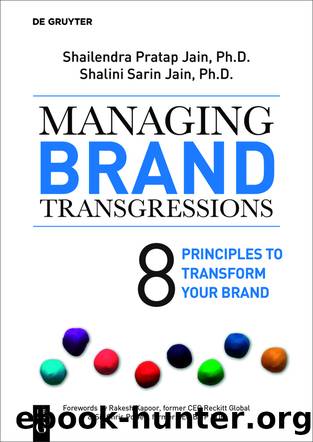Managing Brand Transgressions (for Raymond Rhine) by Shailendra Pratap Jain Shalini Sarin Jain

Author:Shailendra Pratap Jain, Shalini Sarin Jain
Language: eng
Format: epub
Publisher: De Gruyter
Published: 2024-06-05T16:14:56.676000+00:00
The Choice
Merck had a decision to make. Should it invest about $200 million to produce a safe, effective drug suitable for the community-wide treatment of river blindness? Innumerable challenges existed. Even if it did succeed, the monetary returns would likely be close to zero because neither the recipients nor their governments could afford the drug even if it were to be sold at cost. Also, given the patientsâ remote locations, distribution would be expensive, even if possible. They could also not rule out isolated instances of improper use and unintended consequences in developing country settings. Importantly, the drug would have to undergo expensive clinical trials to prove its efficacy and if the new derivative proved harmful to humans, Merckâs best-selling animal drug and its reputation could both suffer (Gates, 2014). There was also a real possibility that no international organization, government, or foundation may buy and distribute the drug. Indeed, Merck approached many agencies, from WHO to USAID, to find a way to distribute the drug, but none were interested. Finally, at a press conference on October 27, 1987, Merck announced that it would manufacture and ship Mectizan at no cost to whomever or wherever it was needed, for as long it was needed to control river blindness. It partnered with local governments and private agencies for distribution. This was a landmark event in the history of global health as Merck showed the courage to place social need over profits.
Since 1987, Merck has manufactured and shipped more than 2.5 billion tablets of Mectizan at no charge, in 37 countries at a cost of $3.9 billion. It is estimated that this has prevented 40,000 cases of blindness annually, returned to use 62 million acres of farmland, and added 7.5 million years of productive adult labor to national workforces (Merck, 2022). According to one study, two areas in Africa have gained an estimated $573 million in net benefits over a 40-year period (Waters et al., 2004, p. A16). Merck expanded the Mectizan Donation Program to include the prevention of elephantiasis (lymphatic filariasis) in African countries where the disease coexists with river blindness. Today, the Merck Mectizan Donation Program includes partnerships with numerous non-governmental and governmental organizations, private foundations, WHO, the World Bank, United Nations Childrenâs Fund (UNICEF), and the United Nations Development Programme (UNDP). The United Nations reports that river blindness may soon be eradicated.
Merck, in its actions of helping develop a new drug and giving it away for free, believed that despite the substantial cost, placing principle over profit vindicates their decision, which was grounded in its core valuesâthat its business is preserving and improving human life and doing it with the highest standards of ethics and integrity. This remarkable story has its genesis in Japan where in the late 1970s, Satoshi Omura of Tokyoâs Kitasato Institute developed a soil-dwelling bacteria called Streptomyces that was extremely successful at killing parasites. He sold this culture to Merck, USA, who bought it to treat Japanese citizens plagued by tuberculosis after World War II.
Download
This site does not store any files on its server. We only index and link to content provided by other sites. Please contact the content providers to delete copyright contents if any and email us, we'll remove relevant links or contents immediately.
| Direct | Global |
| Industrial | Multilevel |
| Product Management | Research |
| Telemarketing | Web Marketing |
Influence: The Psychology of Persuasion by Robert B. Cialdini(4715)
The Miracle Morning by Hal Elrod(4637)
The Hacking of the American Mind by Robert H. Lustig(4318)
Pre-Suasion: A Revolutionary Way to Influence and Persuade by Robert Cialdini(4150)
Unlabel: Selling You Without Selling Out by Marc Ecko(3589)
Ogilvy on Advertising by David Ogilvy(3511)
Hidden Persuasion: 33 psychological influence techniques in advertising by Marc Andrews & Matthijs van Leeuwen & Rick van Baaren(3472)
Purple Cow by Seth Godin(3141)
Who Can You Trust? by Rachel Botsman(3088)
Kick Ass in College: Highest Rated "How to Study in College" Book | 77 Ninja Study Skills Tips and Career Strategies | Motivational for College Students: A Guerrilla Guide to College Success by Fox Gunnar(3076)
The Marketing Plan Handbook: Develop Big-Picture Marketing Plans for Pennies on the Dollar by Robert W. Bly(2975)
This Is Marketing by Seth Godin(2973)
I Live in the Future & Here's How It Works by Nick Bilton(2935)
The Power of Broke by Daymond John(2898)
Building a StoryBrand by Donald Miller(2842)
The Tipping Point by Malcolm Gladwell(2827)
The 46 Rules of Genius: An Innovator's Guide to Creativity (Voices That Matter) by Marty Neumeier(2796)
Draw to Win: A Crash Course on How to Lead, Sell, and Innovate With Your Visual Mind by Dan Roam(2735)
Market Wizards by Jack D. Schwager(2643)
